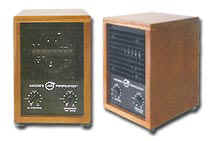Toxic Mold
 |
If mold is a
problem, we have the answer to your problem. Try LightningAir
Products. Don't live with this problem anymore. Order
today! |
View Our
Entire Products List
Some Questions & Answers
How do molds get in
the indoor environment and how do they grow?
Molds naturally grow
in the indoor environment. Mold spores may also enter your house
through open doorways, windows, heating, ventilation, and air
conditioning systems. Spores in the air outside also attach
themselves to people and animals, making clothing, shoes, bags,
and pets convenient vehicles for carrying mold indoors.
When mold spores drop on places where there is excessive
moisture, such as where leakage may have occurred in roofs,
pipes, walls, plant pots, or where there has been flooding, they
will grow. Many building materials provide suitable nutrients
that encourage mold to grow. Wet cellulose materials, including
paper and paper products, cardboard, ceiling tiles, wood, and
wood products, are particularly conducive for the growth of some
molds. Other materials such as dust, paints, wallpaper,
insulation materials, drywall, carpet, fabric, and upholstery,
commonly support mold growth.
What is
Stachybotrys chartarum (Stachybotrys atra)?
Stachybotrys
chartarum (also known by
its synonym Stachybotrys atra) is a greenish-black mold.
It can grow on material with a high cellulose and low nitrogen
content, such as fiberboard, gypsum board, paper, dust, and
lint. Growth occurs when there is moisture from water damage,
excessive humidity, water leaks, condensation, water
infiltration, or flooding. Constant moisture is required for its
growth. It is not necessary, however, to determine what type of
mold you may have. All molds should be treated the same with
respect to potential health risks and removal.
Who are the people
who are most at risk for health problems associated with
exposure to mold?
People with allergies
may be more sensitive to molds. People with immune suppression
or underlying lung disease are more susceptible to fungal
infections.
How do you know if
you have a problem?
Large infestations can
usually be seen or smelled.
What should people to
do if they determine they have Stachybotrys chartarum (Stachybotrys
atra) in their buildings or homes?
A. Whether it is Stachybotrys
chartarum (Stachybotrys atra) or other types,
indicates that there is a problem with water or moisture. This
is the first problem that needs to be addressed. Mold can be
cleaned off surfaces with a weak bleach solution. Mold under
carpets typically requires that the carpets be removed. Once
mold starts to grow in insulation or wallboard the only way to
deal with the problem is by removal and replacement. We do not
believe that one needs to take any different precautions with Stachybotrys
chartarum (Stachybotrys atra), than with other molds.
In areas where flooding has occurred, prompt cleaning of walls
and other flood-damaged items with water mixed with chlorine
bleach, diluted 10 parts water to 1 part bleach, is necessary to
prevent mold growth. Never mix bleach with ammonia. Moldy items
should be discarded.
How do you keep it out
of buildings and homes?
A. As part of routine
building maintenance, buildings should be inspected for evidence
of water damage and visible mold. The conditions causing growth
(such as water leaks, condensation, infiltration, or flooding)
should be corrected to prevent growth.
Specific
Recommendations:
- Keep humidity level in house
below 50%.
- Use air conditioner or a
dehumidifier during humid months.
- Be sure the home has adequate
ventilation, including exhaust fans
in kitchen and bathrooms.
- Use mold inhibitors which can
be added to paints.
- Clean bathroom with
mold-killing products.
- Do not carpet bathrooms.
- Remove and replace flooded
carpets.
I found mold growing
in my home; how do I test the mold?
We are pleased to be
able to offer you an easy to use
mold test kit. We
recommend you test several areas at one time. If you are
susceptible to mold and mold is seen or smelled, there is a
potential health risk; therefore, no matter what type of mold is
present, you should arrange for its removal. Furthermore,
reliable sampling for mold can be expensive, and standards for
judging what is and what is not an acceptable or tolerable
quantity of mold have not been established.
FAQ
Learn More
Do ozone generators
work? Learn More
View Products
|

